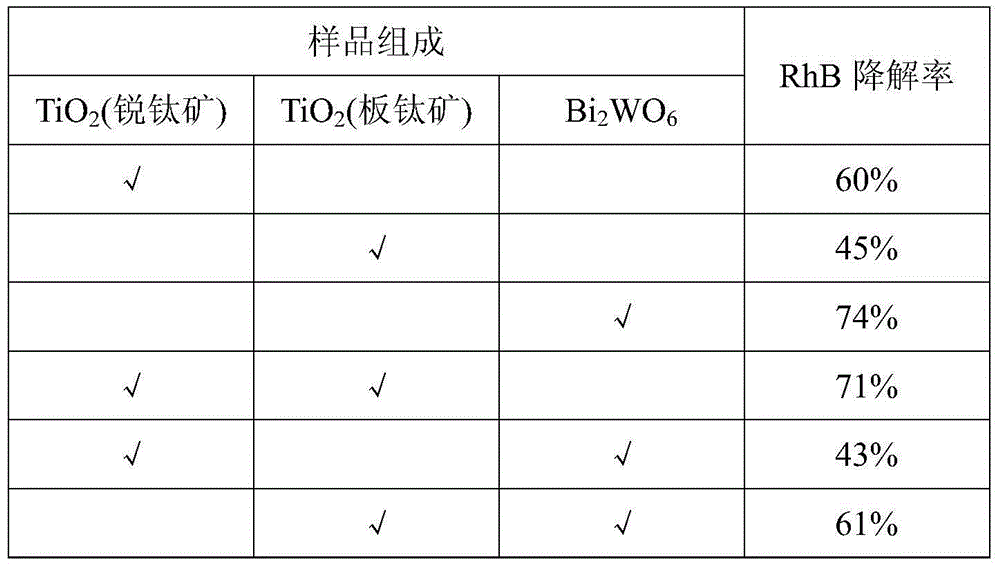Visible light-sensitive semiconductor composite photocatalytic material and preparation method thereof
A composite photocatalysis and visible light technology, applied in chemical instruments and methods, physical/chemical process catalysts, metal/metal oxide/metal hydroxide catalysts, etc., can solve the problem of easy recombination, confinement and quantum efficiency of photogenerated carriers Low-cost problems, to achieve the effect of abundant raw material sources, low preparation cost, and high catalytic activity
- Summary
- Abstract
- Description
- Claims
- Application Information
AI Technical Summary
Problems solved by technology
Method used
Image
Examples
Embodiment 1
[0029] Embodiment 1: The visible light-sensitized semiconductor composite photocatalytic material provided in this embodiment is TiO with multilevel heterojunction structure 2 / Bi 2 WO 6 Composite crystals, made of the following molar ratio components: TiO 2 Nanocrystals 1-30: tungsten salt 1: bismuth salt 1.8-2.2.
[0030] The TiO 2 Nanocrystals include anatase type or brookite type or rutile type, or mixed crystal TiO with two or more phases 2 . The tungsten salt is one of tungsten-containing tungstate or chloride salt. The bismuth salt is one of bismuth-containing nitrate, acetate or chloride salt.
[0031] The visible light-sensitized semiconductor composite photocatalytic material is carried out in a reaction system solvent, and the reaction system solvent is composed of water and ethylene glycol in a volume ratio of (0-80):(80-0) mixed solution.
[0032] A preparation method of the above-mentioned visible light-sensitized semiconductor composite photocatalytic mat...
Embodiment 2
[0042] Embodiment 2: The visible light-sensitized semiconductor composite photocatalytic material and preparation method thereof provided in this embodiment, its components and steps are all the same as in Embodiment 1, the difference is:
[0043]The visible light-sensitized semiconductor composite photocatalytic material is made of the following molar ratio components: TiO 2 Nanocrystal 10: Tungsten salt 1: Bismuth salt 2.0.
[0044] The preparation method of the visible light-sensitized semiconductor composite photocatalytic material comprises the following steps:
[0045] (1) According to anatase and brookite mixed crystal TiO 2 Weigh anatase and brookite mixed crystal TiO with sodium tungstate in a molar ratio of 10:1 2 and sodium tungstate;
[0046] (2) Anatase and brookite mixed crystal TiO 2 Mix with sodium tungstate and disperse in 40mL water to form suspension A;
[0047] (3) Weigh bismuth nitrate according to the tungsten to bismuth molar ratio of 1:2 in step (1...
Embodiment 3
[0049] Embodiment 3: The visible light-sensitized semiconductor composite photocatalytic material and preparation method thereof provided in this embodiment, its components and steps are all the same as those in Embodiment 1 and 2, the difference is that:
[0050] The visible light-sensitized semiconductor composite photocatalytic material is made of the following molar ratio components: TiO 2 Nanocrystal 1: Tungsten salt 1: Bismuth salt 1.8.
[0051] The preparation method of the visible light-sensitized semiconductor composite photocatalytic material comprises the following steps: (1) according to anatase TiO 2 Weigh anatase TiO with tungsten hexachloride in a molar ratio of 1:1 2 and tungsten hexachloride;
[0052] (2) Anatase TiO 2 Mix with tungsten hexachloride and disperse in 40mL water to form suspension A;
[0053] (3) Weigh bismuth acetate according to the tungsten to bismuth molar ratio of 1:1.9 in step (1), and dissolve it in 40mL of ethylene glycol to form solu...
PUM
 Login to View More
Login to View More Abstract
Description
Claims
Application Information
 Login to View More
Login to View More - R&D Engineer
- R&D Manager
- IP Professional
- Industry Leading Data Capabilities
- Powerful AI technology
- Patent DNA Extraction
Browse by: Latest US Patents, China's latest patents, Technical Efficacy Thesaurus, Application Domain, Technology Topic, Popular Technical Reports.
© 2024 PatSnap. All rights reserved.Legal|Privacy policy|Modern Slavery Act Transparency Statement|Sitemap|About US| Contact US: help@patsnap.com









